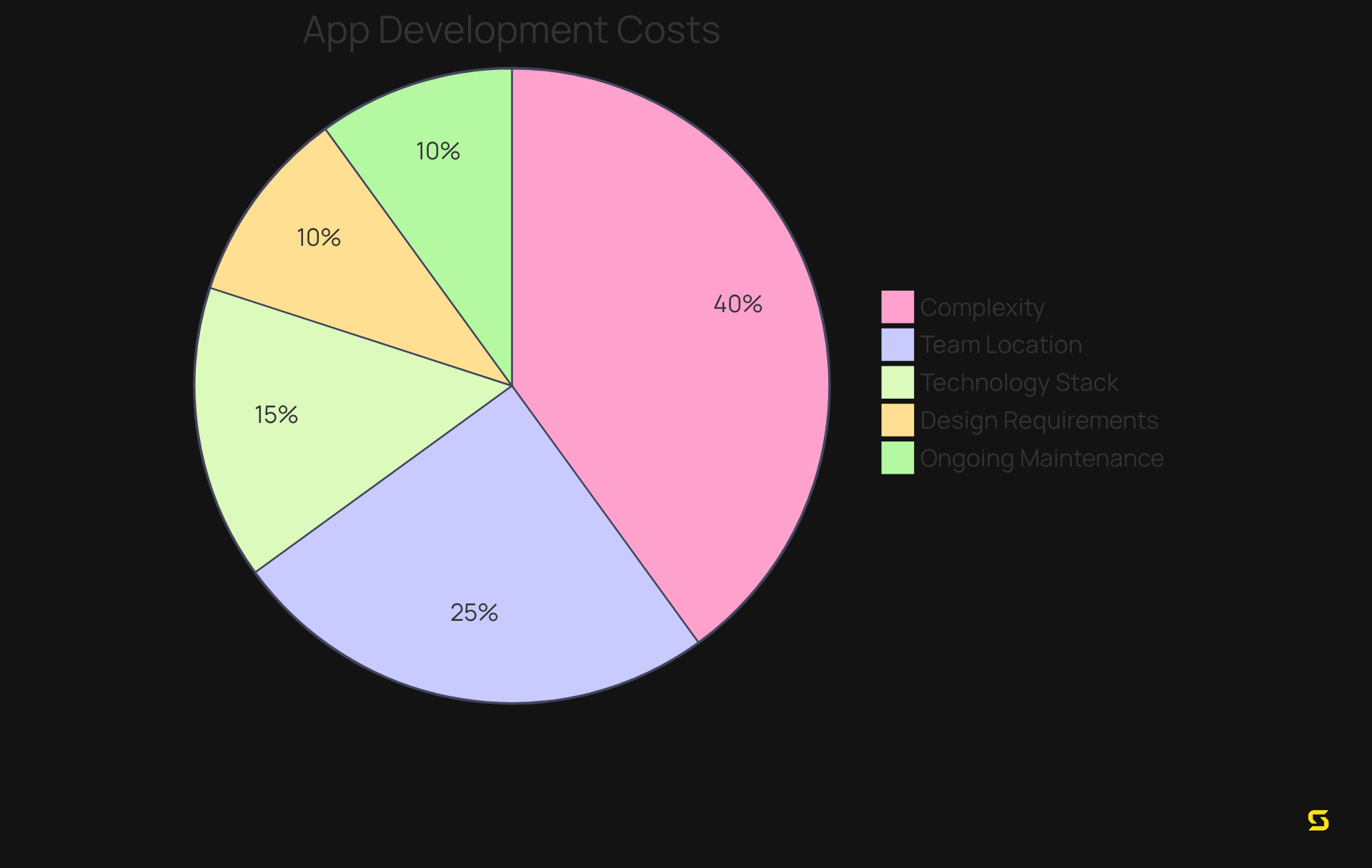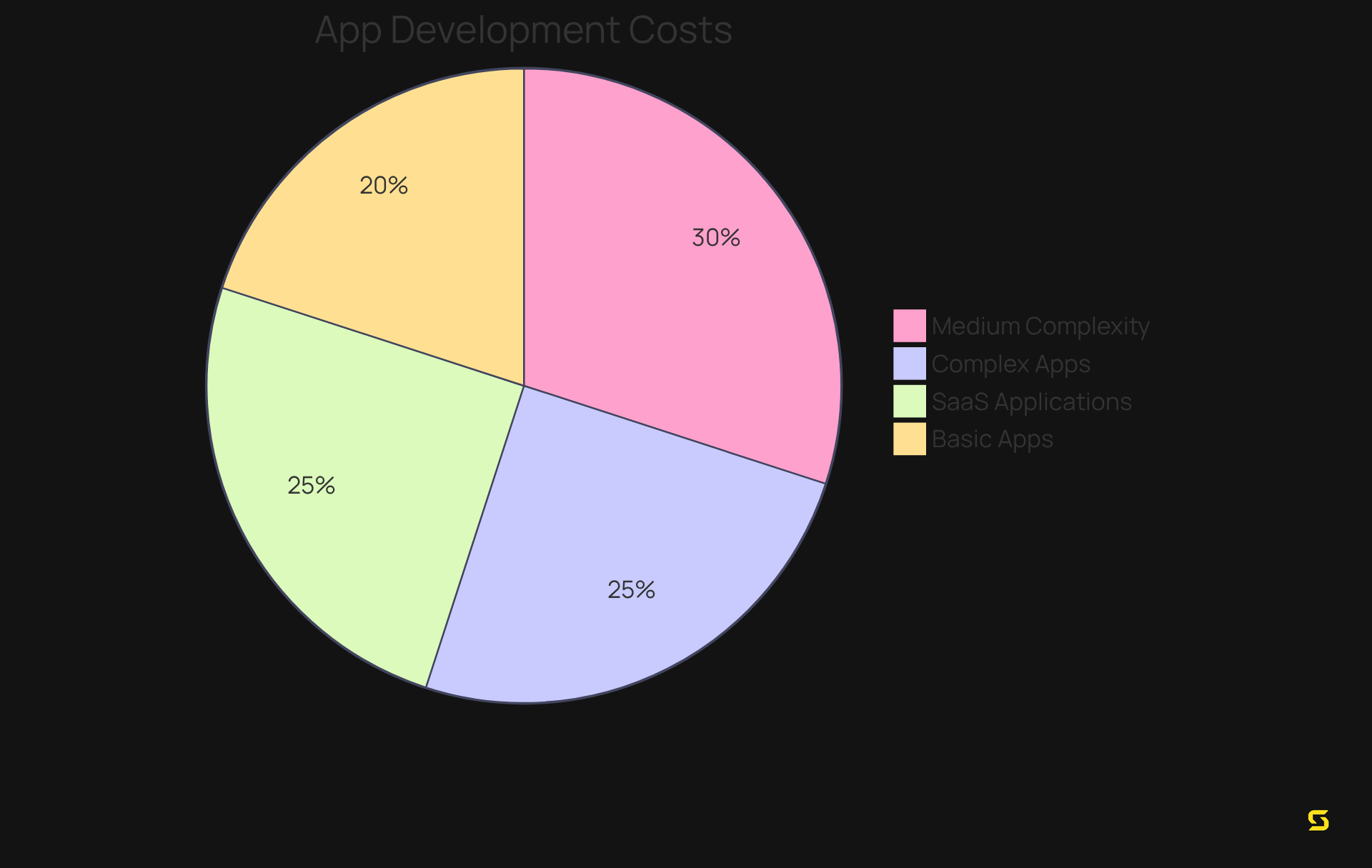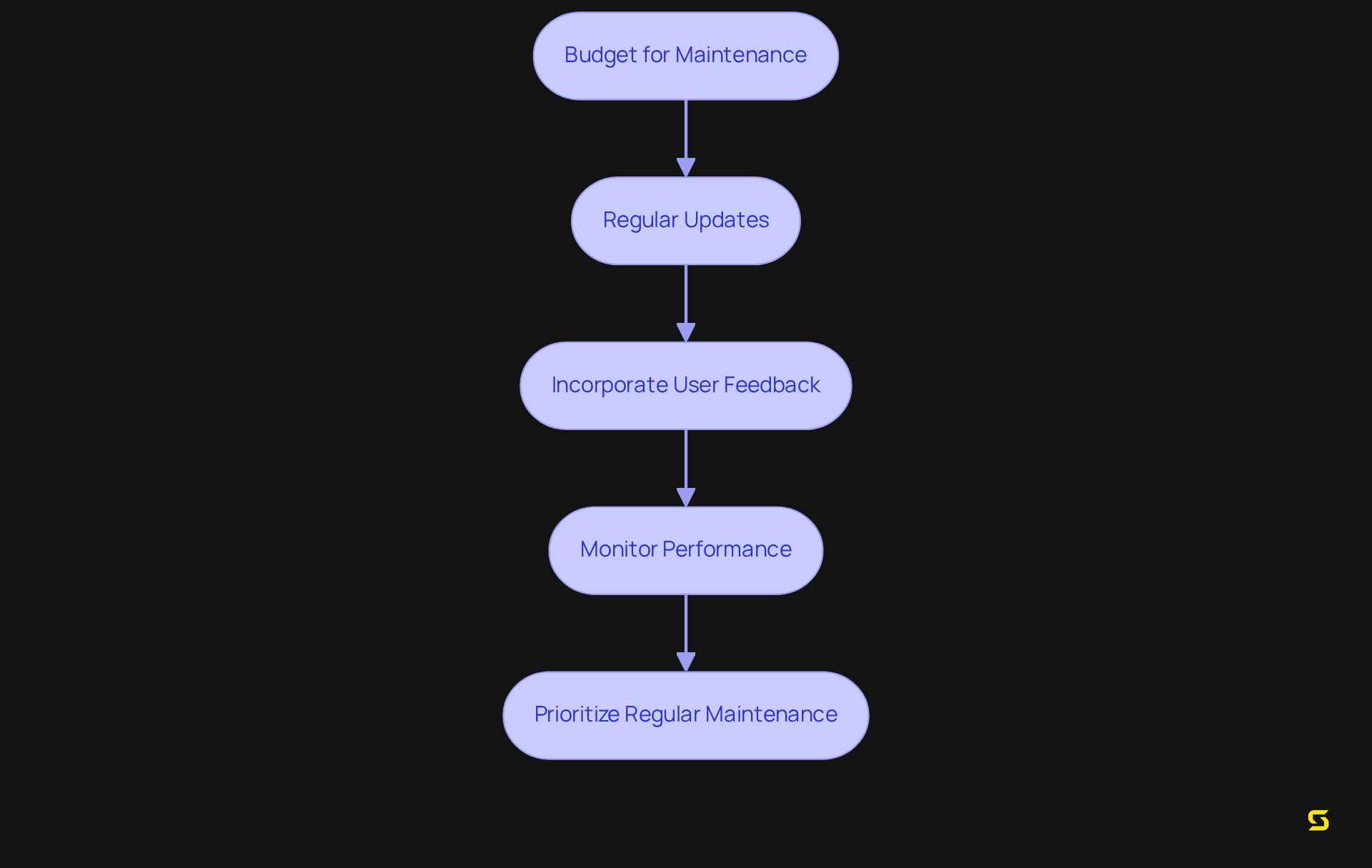Overview
The cost of developing an app is significantly influenced by critical factors such as complexity, team location, technology stack, and design requirements. It is essential to recognize that more complex applications can exceed $100,000. However, by strategically outsourcing to regions with lower labor costs and leveraging cross-platform frameworks, businesses can substantially reduce their overall expenses. This underscores the necessity of strategic planning in app development, ensuring that investments yield optimal returns.
Introduction
Understanding the financial landscape of app development is essential for anyone aiming to create a successful software as a service (SaaS) product. Costs can vary dramatically based on complexity, team location, and technology choices, presenting potential developers with a maze of decisions that can significantly impact their budgets.
What effective strategies can be employed to navigate these challenges and ensure a successful outcome without excessive expenses? This article explores the key factors influencing app development costs and provides practical strategies for achieving SaaS success while managing expenditures.
Explore Key Factors Influencing App Development Costs
-
The complexity of the app is a pivotal factor that influences the develop app cost. The develop app cost can significantly increase for more complex applications, which are characterized by numerous features, integrations, and sophisticated architecture. For instance, the develop app cost for a sophisticated mobile application on a single platform can easily exceed $100,000, with expenses potentially escalating to $550,000 for highly advanced applications. Additionally, intricate applications featuring advanced functionalities may develop app cost of $150,000 or more, underscoring the significant investment variations based on complexity. In contrast, simpler apps can have a develop app cost starting at approximately $10,000 to $40,000.
-
Team Location: The geographical location of the development team significantly affects the develop app cost. Developers in North America typically charge between $150 to $300 per hour, whereas those in Eastern Europe or Asia may charge as little as $25 to $75 per hour. This disparity presents substantial savings opportunities for companies looking to reduce their develop app cost by outsourcing to regions with lower labor costs.
-
The choice of technology stack also plays a crucial role in determining the develop app cost. Choosing cross-platform frameworks like Flutter or React Native can help reduce the develop app cost by 30-40% compared to traditional native development. This strategy enables companies to effectively reach both iOS and Android audiences, maximizing their market potential while minimizing expenses.
-
The design requirements highlight that high-quality UI/UX design is essential for user engagement, but it can significantly develop app cost. The develop app cost for custom designs can range from $5,000 for basic interfaces to over $50,000 for polished, tailored experiences. Investing in quality design is imperative, as it directly influences user retention and satisfaction, ultimately impacting the app's success.
-
Ongoing maintenance and updates contribute to the develop app cost, which must be factored into the overall budget. Typically, maintenance costs account for 15% to 25% of the develop app cost annually. This includes regular updates, bug fixes, and security patches, all vital for sustaining app functionality and ensuring customer satisfaction. For example, annual expenses for bug fixing can fluctuate between $1,000 to $5,000, highlighting the importance of planning for these recurring costs.

Analyze App Types and Their Cost Implications
-
Basic Apps: Typically, these applications range from $5,000 to $50,000, providing essential functionalities alongside a straightforward user interface.
-
Medium Complexity Apps: The costs associated with medium complexity apps vary from $50,000 to $150,000. These applications incorporate additional features and necessitate more extensive development time, often requiring 4-6 months to complete. For example, a medium complexity app with integrated messaging features might range from €12,750 to €29,750, contingent upon the specific functionalities and design elements involved. It is crucial to consider concealed expenses, such as revisions, software licenses, and unforeseen technical issues, which can inflate the develop app cost by an additional 10-20%.
-
Complex Apps: The development costs for complex applications can exceed $250,000, especially when advanced functionalities such as AI integration or intricate backend systems are involved. The combination of AI and machine learning can escalate expenses by 30-300% over the base price, underscoring the demand for skilled professionals and advanced tools.
-
SaaS Applications: The costs associated with developing SaaS applications fluctuate significantly, starting at $25,000 for basic versions and potentially surpassing $500,000 for more sophisticated solutions. Factors influencing these costs include necessary features, scalability, and compliance with security regulations such as GDPR and CCPA, which require additional investments for robust security measures. Furthermore, ongoing expenses for maintenance, hosting, and user acquisition can greatly impact the overall budget, with average maintenance costs estimated between $2,000 and $4,000 monthly.
In summary, understanding the financial implications of different app types is vital for effective budgeting and planning to manage the develop app cost in the app development process. Strategies such as initially creating a Minimum Viable Product (MVP) or utilizing no-code solutions can optimize budgets, while selecting a scalable cloud-based infrastructure is essential for managing long-term expenses.

Implement Cost-Reduction Strategies in App Development
-
Defining core features and prioritizing essential elements for the Minimum Viable Product (MVP) is crucial for minimizing the develop app cost. By concentrating on features that meet fundamental client requirements, companies can optimize processes and prevent excessive expenses. This approach not only clarifies app requirements but also facilitates early user feedback, vital for refining the product. As the JetRuby Team states, "The MVP should solve important problems immediately," underscoring the importance of defining core features.
-
Outsource Creation: Delegating app creation to regions with lower labor costs can significantly reduce expenditures while maintaining quality. For instance, Eastern Europe and Asia offer talented developers at competitive rates, with Eastern European app creation costs ranging from $25 to $75 per hour. This strategy enables startups to leverage expertise to reduce the develop app cost without the financial burden of hiring full-time staff, thus accessing a broader talent pool and enhancing project efficiency.
-
Utilize No-Code/Low-Code Platforms: In 2025, leveraging no-code and low-code platforms can expedite creation processes and help reduce the develop app cost. These tools empower teams to develop applications with minimal coding, allowing for faster iterations and reducing the need for extensive technical resources. As noted, 'In 2025, businesses can achieve an affordable develop app cost by leveraging cost-effective strategies,' making this approach particularly advantageous for startups aiming to launch quickly and efficiently.
-
Leverage Existing Code: Reusing code from previous projects can lead to significant time and cost savings. By integrating pre-built components and frameworks, developers can avoid redundant work and focus on customizing features that enhance user experience. This practice not only accelerates progress but also contributes to a more stable and reliable application.
-
Agile Development Methodology: Implementing Agile methodologies fosters flexibility and responsiveness throughout the development process. By dividing projects into manageable sprints, teams can identify issues early and implement necessary adjustments, ultimately reducing rework expenses. This iterative approach ensures that the final product aligns closely with user expectations and market demands. Moreover, continuous upkeep expenses for an app are approximately 15-20% of the develop app cost annually, highlighting the importance of planning for these payments.

Plan for Maintenance and Long-Term Cost Management
-
Budget for Maintenance: Allocate 15-20% of the develop app cost each year for maintenance. This proactive budgeting mitigates unexpected expenses and ensures the app remains functional and secure.
-
Regular Updates: Establish a schedule for periodic updates to keep the app aligned with expectations and technological advancements. Regular updates not only enhance security but also boost satisfaction, with frequent updates resulting in a 75% retention rate compared to only 30% for infrequent updates. In fact, regular updates can lead to a fourfold increase in client retention, underscoring the critical nature of maintaining an update schedule.
-
Actively incorporate feedback from users into the development cycle. This practice not only improves the app's functionality but also fosters customer loyalty, as individuals feel their input is valued. For instance, 30% of developers utilize updated app icons to enhance app visibility, illustrating how user feedback can be leveraged to improve engagement. Engaging with users regarding updates can uphold the app's reputation as a reliable tool.
-
Monitor Performance: Utilize analytics tools to track app performance and identify areas for improvement. Consistent performance monitoring can uncover issues before they escalate, enabling prompt updates that enhance client experience and operational efficiency. Investing in performance monitoring tools, which typically affects the develop app cost between $100 and $500 per month, is essential for effective app maintenance. Neglecting updates can lead to increased security vulnerabilities and user frustration, making it crucial to prioritize regular maintenance.

Conclusion
Understanding the various factors that influence app development costs is essential for anyone embarking on this journey. The intricacies of app complexity, team location, technology choices, design needs, and ongoing maintenance significantly contribute to the overall financial investment required. By grasping these elements, businesses can better strategize their budgets and make informed decisions that align with their development goals.
Key insights reveal that app complexity can drastically alter costs. Simpler applications start at around $10,000, while more advanced solutions may soar beyond $550,000. Additionally, leveraging outsourcing, adopting no-code platforms, and utilizing Agile methodologies can provide substantial cost savings. Regular maintenance and user feedback integration ensure that the app remains functional and relevant, ultimately enhancing user satisfaction and retention.
In light of these considerations, effective planning and strategic decision-making are paramount in managing app development costs. By prioritizing essential features, exploring cost-reduction strategies, and committing to ongoing maintenance, businesses can optimize their budgets and pave the way for long-term success in the competitive app landscape. Embracing these practices will facilitate a smoother development process and foster a sustainable growth trajectory in the ever-evolving world of technology.
Frequently Asked Questions
What are the key factors that influence app development costs?
The key factors influencing app development costs include the complexity of the app, the geographical location of the development team, the choice of technology stack, design requirements, and ongoing maintenance and updates.
How does app complexity affect development costs?
The complexity of the app significantly impacts development costs. More complex applications can cost over $100,000, with highly advanced applications potentially exceeding $550,000. Conversely, simpler apps may start at around $10,000 to $40,000.
How does the location of the development team impact costs?
The geographical location of the development team affects costs significantly. Developers in North America typically charge between $150 to $300 per hour, while those in Eastern Europe or Asia may charge between $25 to $75 per hour, offering substantial savings for outsourcing.
What role does the technology stack play in app development costs?
The choice of technology stack influences development costs. Using cross-platform frameworks like Flutter or React Native can reduce costs by 30-40% compared to traditional native development, allowing companies to target both iOS and Android users more efficiently.
How do design requirements affect app development costs?
High-quality UI/UX design is crucial for user engagement but can significantly increase development costs. Custom designs can range from $5,000 for basic interfaces to over $50,000 for more polished, tailored experiences.
What are the ongoing costs associated with app maintenance?
Ongoing maintenance and updates typically account for 15% to 25% of the development cost annually. This includes regular updates, bug fixes, and security patches, with annual expenses for bug fixing ranging from $1,000 to $5,000.





